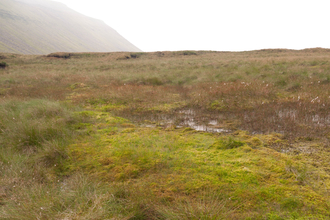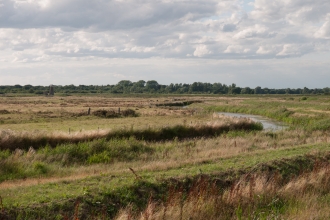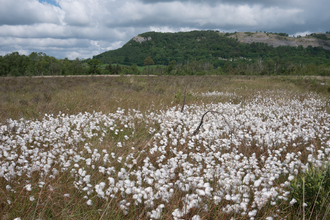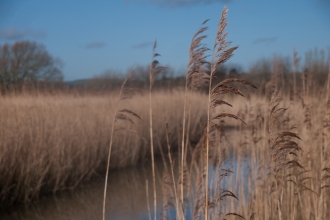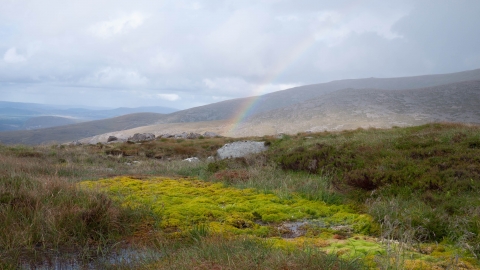
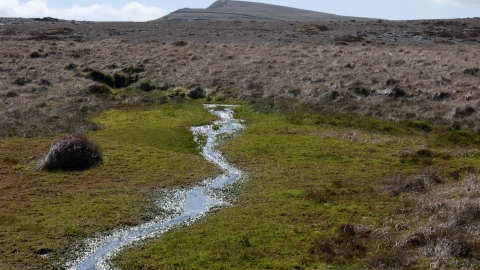
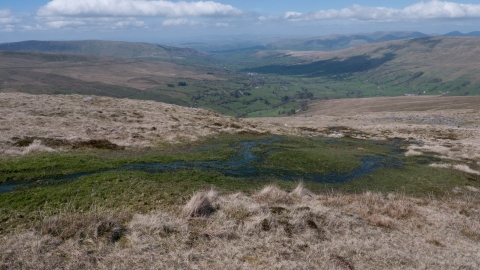
Upland spring, flush and fen
What is it?
Upland spring, flush and fen are all found where groundwater moves gently over thin peat or mineral soils in the hills, moors and mountains in the wet west and north of the UK. At springheads, water trickles out of the ground over soft mats of mosses and liverworts. Green and yellowy-orange patches of the stiff, feather-like curled hook-moss or bright green cushions of upright fountain apple-moss are characteristic.
The water seeps away through flushes of small sedges, rushes and herbs, often with an under-layer of mosses or a thin layer of gravel. Where the water is lime-rich, flushes can be diverse with butterwort, yellow saxifrage, bird’s-eye primrose, grass-of-Parnassus, alpine meadow-rue and dioecious and flea sedges. At lower altitudes, lusher vegetation can also be found, with soft and sharp-flowered rush, flag iris, tall herbs such as meadowsweet and wild angelica and less robust species like ragged-robin, valerian and globeflower. In the warmer south-west of England and Wales, neat stands of water-crowfoot and blinks are found.
Why is it like this?
Water emerges from the ground wherever the water table is high or a layer of impermeable substrate prevents the water from filtering away underground. Series of springs are often located along a contour at the altitude at which the impermeable substrate is found. Where the substrate remains impermeable downslope of the spring, the water fans out and the flow slows and becomes more diffuse, creating flushes. Where flushes occur on deeper soil in gullies and hollows, the greater availability of nutrients can support taller vegetation.
The make-up of the vegetation is dependent on altitude and the chemical nature of the underlying substrate water. Water emerging from limestone is rich in calcium, and can form deposits of lime called tufa. These springs and flushes are more species-rich than their acidic counterparts, and at high altitudes in particular can support many scarce and rare species. Lime-rich flushes are likely to be characterised by pointed spear-moss while more acid conditions suit the softer-looking bog-mosses.
Distribution in the UK
Widely distributed throughout the uplands, particularly in Scotland. Extent unknown.
What to look for
Like other wetlands, upland springs, flushes and fens can support high numbers of invertebrates including craneflies, beetles and spiders. This makes them good feeding areas for upland birds, including waders, ring ouzels, wheatears and grouse chicks.
In the montane zone, spring and flush vegetation support an exceptional array of rare mosses and liverworts. At limestone springs look out for tufa-laden mounts of the orangey curled hook-moss. Arctic-alpine plants are another feature, including a suite of rare sedges and small rushes together with herbs such as Scottish asphodel, purple and yellow mountain saxifrages and alpine bartsia.
Conservation
Upland springs, flushes and fens are often very small and are generally managed as part of the surrounding habitats, usually through grazing.
Lower down, the sward is kept open and suitable for smaller species by grazing livestock. However, the habitat patches are small and the vegetation delicate and susceptible to trampling and poaching.
Mosses and liverworts are susceptible to air pollution and the habitat is also sensitive to the quality, quantity and seasonal availability of water, which is likely to alter with climate change.

